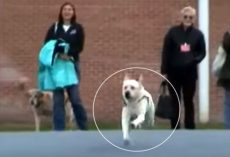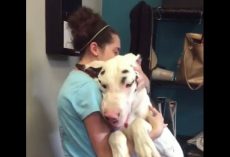If you know someone who is suffering from anxiety that is disabling, meaning they are struggling with leaving their house, a service dog might help them. Service dogs can create a barrier between the anxiety-ridden person and the people wanting to socialize. A PSA service dog and other service dogs do much, much more too.
1. Guide dogs
Assistance dogs who lead visually impaired and blind people around obstacles are one of the most commonly known types of service dogs. While people often expect guide dogs and other assistance dogs to wear vests, the Americans With Disabilities Act does not require a vest.2. Hearing dogs
For people with hearing impairments, these dogs assist by alerting their human to noises such as alarms, doorbells, or crying babies. When the dog hears the sound, they’ll touch their human and lead toward the noise.3. Mobility assistance dogs
These service dogs can perform a wide range of tasks for people with a wide range of mobility issues. According to Service Dogs of America, mobility assistance dogs can bring objects to people, press buttons on automatic doors, serve as a brace for people who are ambulatory, or even help pull a wheelchair up a ramp.4. Diabetic alert dogs
Also known as DADs, these medical alert dogs can provide independence and security by alerting to chemical changes in their handler’s blood sugar.5. Seizure alert dog
Seizure alert dogs are a controversial type of service dog who react with a specific type of behavior right before her human has a seizure.6. Seizure response dogs
Not to be confused with seizure alert dogs, seizure response dogs are trained to provide help to a person experiencing an epileptic seizure, not to predict the seizure.7. Psychiatric service dogs
This versatile category of service dog assists people who are suffering from issues like depression, anxiety, and most often post-traumatic stress disorder. Many PTSD sufferers find that having a service dog to care for forces the human to also take care of themselves.8. Autism support dogs
For kids on the autism spectrum, these dogs help provide a sense of predictability as the children navigate social settings, including school. In addition to improving the child’s quality of life by reducing isolation and comforting the child in stressful times, these dogs are also trained to keep children from running away.9. FASD service dogs
An emerging category of service dog, these dogs support children who were exposed to alcohol prenatally, and have been diagnosed with fetal alcohol spectrum disorders (FASDs). According 4 Paws for Ability, its FASD dogs are trained similarly to autism service dogs and can be trained to interrupt a repetitive behavior.10. Allergy detection dogs
With the rise in food allergies has come another category of medical service dog. Allergy detection dogs are trained to sniff out and alert to the odor of things such as peanuts or gluten.Other kinds of working dogs, including therapy dogs and emotional support dogs, are not classified as service animals as they’re not trained to perform a specific task to help their handlers.
It's nice that people who have serious illnesses can rely on their service dog to provide a service that they need. What's more, service dogs provide a great deal of comfort, especially to a person who has PTSD or depression. You can read more about a service dog's tasks on Dogster.
We want to take the time to say thank you to our service dogs, you provide so much care and attention to the people who need you!











Stacy Lyn Rogers
- Edit
That face❤️
Phil Henke
- Edit
Just LOVE this article!! That Pug’s face just seems to say it all….love, contentment, and totally relaxed and trusting!! The BEST!!!
Jonah Miller
- Edit
Laura Villada